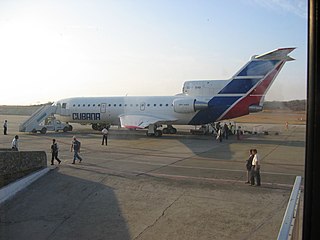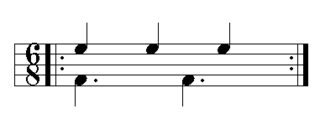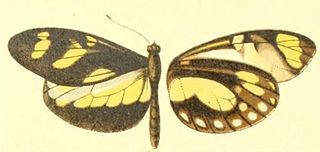
José Martí International Airport, sometimes known by its former name Rancho Boyeros Airport, is an international airport located in the municipality of Boyeros, 20 kilometres (12 mi) southwest of the centre of Havana, Cuba, and is a hub for Cubana de Aviación and Aerogaviota, and former Latin American hub for the Soviet airline Aeroflot. It is Cuba's main international airport, and serves several million passengers each year. The facility is operated by Empresa Cubana de Aeropuertos y Servicios Aeronáuticos (ECASA).

Cubana de Aviación S.A., commonly known as Cubana, is Cuba's flag carrier, as well as the country's largest airline. It was founded in October 1929, becoming one of the earliest airlines to emerge in Latin America. It has its corporate headquarters in Havana, and its main base is located at José Martí International Airport. Originally a subsidiary of Pan American World Airways and later a private company owned by Cuban investors, Cubana has been wholly owned by the Cuban government since May 1959.
The music of Cuba, including its instruments, performance, and dance, comprises a large set of unique traditions influenced mostly by west African and European music. Due to the syncretic nature of most of its genres, Cuban music is often considered one of the richest and most influential regional music in the world. For instance, the son cubano merges an adapted Spanish guitar (tres), melody, harmony, and lyrical traditions with Afro-Cuban percussion and rhythms. Almost nothing remains of the original native traditions, since the native population was exterminated in the 16th century.
Bolero is a genre of song which originated in eastern Cuba in the late 19th century as part of the trova tradition. Unrelated to the older Spanish dance of the same name, bolero is characterized by sophisticated lyrics dealing with love. It has been called the "quintessential Latin American romantic song of the twentieth century".
The tres is a three-course chordophone of Cuban origin. The most widespread variety of the instrument is the original Cuban tres with six strings. Its sound has become a defining characteristic of the Cuban son and it is commonly played in a variety of Afro-Cuban genres. In the 1930s, the instrument was adapted into the Puerto Rican tres, which has nine strings and a body similar to that of the cuatro.

Antonio Maceo Airport is an international airport located in Santiago, Cuba.

Dionisio Jesús Valdés Rodríguez, better known as Chucho, is a Cuban pianist, bandleader, composer and arranger whose career spans over 50 years. An original member of the Orquesta Cubana de Música Moderna, in 1973 he founded the group Irakere, one of Cuba's best-known Latin jazz bands.
Son cubano is a genre of music and dance that originated in the highlands of eastern Cuba during the late 19th century. It is a syncretic genre that blends elements of Spanish and African origin. Among its fundamental Hispanic components are the vocal style, lyrical metre and the primacy of the tres, derived from the Spanish guitar. On the other hand, its characteristic clave rhythm, call and response structure and percussion section are all rooted in traditions of Bantu origin.

Arroz a la cubana or arroz cubano is a rice dish popular in Spain, the Philippines, and parts of Latin America. Its defining ingredients are rice and a fried egg. A fried banana and tomato sauce (sofrito) are so frequently used that they are often considered defining ingredients too.

Cubana de Aviación Flight 455 was a Cuban flight from Barbados to Jamaica that was brought down on 6 October 1976 by a terrorist bomb attack. All 73 people on board the Douglas DC-8 aircraft were killed after two time bombs went off and the plane crashed into the sea. The crash killed every member of the Cuban national fencing team.

The Sierra Maestra is a mountain range that runs westward across the south of the old Oriente Province in southeast Cuba, rising abruptly from the coast. The range falls mainly within the Santiago de Cuba and in Granma Provinces. Some view it as a series of connecting ranges, which join with others to the west. At 1,974 m (6,476 ft), Pico Turquino is the range's – and the country's – highest point. The area is rich in minerals, especially copper, manganese, chromium, and iron.

Criolla is a genre of Cuban music which is closely related to the music of the Cuban Coros de Clave and a genre of Cuban popular music called Clave.

Picadillo is a traditional dish in many Latin American countries including Mexico and Cuba, as well as the Philippines. It is made with ground meat, tomatoes, and also raisins, olives, and other ingredients that vary by region. The name comes from the Spanish word picar, meaning "to mince".
Cuban folk music includes a variety of traditional folk music of Cuba, and has been influenced by the Spanish and the African culture as well as the remaining indigenous population of the Caribbean.
Cubana de Aviación S.A is Cuba's largest airline and flag carrier, it has also a Cargo version named a Cubana de Aviación Cargo S.A.Cubana de Aviación was created on October 8 1929, operating Sikorsky S-38. After the Cuban Revolution, the airline started operating Soviet aircraft like the An-24, Il 18, Il 62m, and Tu-154B2.

Dismorphia is a genus of butterflies in the subfamily Dismorphiinae.

Dismorphia laja is a butterfly in the family Pieridae. It is found in northern South America.

Cuban Sign Language, is the language used by the Deaf community in Cuba. There are approximately 19,000 users of the language. Cuban Sign Language is an important part of the culture of the Deaf community in Cuba.

Pambiche Cocina and Repostería Cubana, or simply Pambiche, is a Cuban restaurant located in northeast Portland, Oregon.

The Hotel Pasaje was a hotel located on Paseo del Prado between San José and Dragones, facing the National Capitol in Havana, Cuba.















